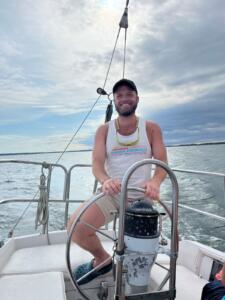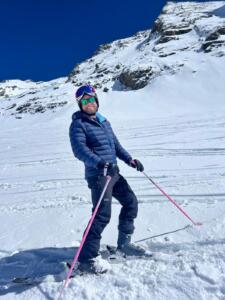Jeffrey Hanft is a Program Manager whose work modernizing fare collection systems in major U.S. markets earned him Genfare’s highest employee distinction, the President’s Award, in 2025.
Jeff has a deep background in technology-related product and project management related to mobility and public transit. He attended the University of Delaware and earned his Master’s in Engineering from Northwestern University. Jeff applies that expertise to collaborating with Genfare’s agency partners to improve service, increase ridership, and optimize operations. As a New Yorker, he also relies on public transit himself.
Keep reading Jeff’s employee spotlight to discover what he enjoys most about his work, and how one of his very adventurous hobbies has earned him the title of skipper.
You’ve led fare collection system upgrades for transit agencies in Baltimore, Atlanta, and Philadelphia. After a foray into the oil and gas industry, how did you get your start in public transit?
I met the Chief of Operations Planning for New York City Transit while I was working on my thesis at Northwestern, and for many years I worked at that agency as a data scientist doing planning for their different rail services. That involved consuming the data that the fare collection system created and helping plan new service, new capital projects, and all sorts of initiatives around data and ridership.
Sounds like your next job involved a deep dive into real-time data products.
I worked in product and project management for a transit technology firm, helping define new products and bring them online, such as real-time passenger information mobile apps, digital signage, onboard announcements, and the APIs that feed Google Maps. I found the real-time passenger information products to be very interesting.
Tell us about your foray into the world of startups.
I worked remotely for a series of venture capital-funded mobility technology startups in San Francisco’s Bay Area. They were trying to build tools for cities to manage, monetize, and create policy around infrastructure assets such as Amazon and UPS deliveries, and services like Lyft, Uber, micromobility scooters and bikes. These are all the things that consume the public infrastructure, whether it’s the curb, or sidewalk, or bike lanes, but that may not necessarily be managed by or have policies executed or monetized by the city.
At Genfare, you’ve been recognized for your collaborative spirit and willingness to go above and beyond for transit agency partners. What do you most enjoy about your work?
My favorite thing is presenting clear and tangible value to our customers. We have partner agencies that are really happy to be working with us, and we are, very clearly, delivering value to them. And, working with the brain trust we have at Genfare, we sometimes get to be the ones who ideate and think of how we’re going to deliver that value to them, leveraging the next generation of technology, or the next set of tools that will help agencies collect fares and manage those systems.
You’ve said that Genfare is not just evolving fare collection systems, but elevating public transportation. How so?
I live in New York City, and I don’t have a car. I haven’t had a car in 14 years; it’s really frustrating to me when fare payment is a barrier to ridership. You should never miss a train because you’re fumbling to make a small transaction. Small-value transactions should not be the deterrent that keeps people from riding. What we do to decrease the friction on fare payment is a big part of compelling riders to come back on board.
How do you get around New York City?
I ride the C & E [subway] train lines and use the Citi Bike bike-sharing system a lot.
What strikes you most about the people who work in this sector?
What I like is that transit agencies are not competitors, but collaborators. They’re like colleagues; they all want each other to succeed. When I worked for New York City Transit, for example, we had opportunities to collaborate with other agencies through information sharing and knowledge transfer across agencies. It’s not like Boston wants New York City’s ridership to fall because it somehow benefits them, right? They want them to have good on-time performance.
How does your work tie into that?
As a vendor, you have the opportunity to help facilitate that collaboration right at the project level. We can connect people from other projects through how they’ve implemented solutions. So, I think that is a really neat attribute of working within this industry space.
What do you see as the key values in public transit?
It’s about being sustainable, and there’s economic justice, environmental justice, and social justice all balled into the core values and mission of public transportation.
What are agency partners getting most excited about when they’ve completed an upgrade to their fare collection systems?
One thing I think they like is the availability of data and new opportunities to get real-time data. So, for example, we are moving from a place where people had to be on agency terminals with data that was half a day stale. Now it’s anywhere, anytime, real-time data at your fingertips, so all of a sudden, we’re empowering people to be better informed about the systems they are managing.
When are your favorite memories of using public transit?
I was a suburban New York kid, so I rode New Jersey Transit a lot. And I have fond memories of using the tram cars and having a bike when I studied abroad and worked summers in Germany – of living in and experiencing walkable cities.


What do you do for fun? I hear you’re into sports.
I have a road bike, and I like bike riding, skiing and sailing. I’ll cycle up the Hudson Valley along the Hudson River, and I ski in Northeast Vermont, or maybe make a trip out west.
How did you get into sailing?
I was inspired while running by a “learn to sail” banner that was on the masts of a fleet of sailboats in the harbor. I now sail with friends, mostly on J24s or Pearson Ensigns out of the Manhattan Yacht Club on the Hudson, or on the iconic New York Bay.
Do you skipper [head the crew]?
Yes, I skipper. I’ve sailed in the Chesapeake and around New York and Rhode Island a lot, and my college friends from the University of Delaware and I have sailed in the British Virgin Islands.
Tell us about a recent adventure.
This summer, we sailed from Sag Harbor, NY, to Robin’s Island, an island located between the twin forks of Long Island. This was the more successful version of a similar trip from 10 years ago, where the same crew of college friends and I ended up grounding the boat while anchoring, and the dogs went overboard. This time, we anchored successfully for lunch and were able to dive off the bow of the boat and swim in the harbor. It was nice to repeat the itinerary, especially as the hiccups of trips past were fresh in our minds. Two of the crew members got married this June, and the anecdote about that first mishap ended up in my officiant’s speech at the wedding!